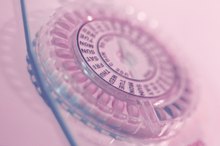Range of Normal Estrogen Levels
Estrogen is a female hormone that is mainly produced by the ovaries. It serves many purposes including helping to regulate the menstrual cycle, preserving bone density and increasing uterine growth. An imbalance in estrogen levels can cause many problems and symptoms. Abnormal bleeding, infertility and menopause all can be caused by estrogen imbalances. A simple blood, urine or saliva sample can be evaluated to determine estrogen levels. Once levels are evaluated, treatment may help to alleviate symptoms of the hormonal imbalances.
Estrogen
Estrogen, a group of hormones, is produced in the pituitary gland and is mainly responsible for the development of female sex organs 2. It consists of three fractions: Estrone, which maily occurs after menopause; estradiol, which is produced in the ovaries and is responsible for ovulation and affects conception and pregnancy; and estriol, which commonly occurs during pregnancy. These three factions are all measured during estrogen testing.
Normal Levels
Symptoms of High TSH Levels
Learn More
The normal range of estrogen varies depending upon the patient's age. Typically a women aged 20 to 29 will have an average level of 149 pg/ml (pictograms per milliliter). A female aged 30 to 39 will average a level of 210 pg/ml. And those over 40 but not in menopause will have an average level of 152 pg/ml. These average levels can vary day to day depending on each female's menstrual cycle.
- The normal range of estrogen varies depending upon the patient's age.
- A female aged 30 to 39 will average a level of 210 pg/ml.
Low Estrogen Levels
Estrogen levels are considered low when the range is 10 to 20 pg/ml. This can be caused by menopause, anorexia and Turner Syndrome. Extreme endurance exercise also can reduce estrogen levels. Some of the symptoms of low estrogen levels are fatigue, hot flashes, night sweats, vaginal dryness and difficulty concentrating. Low levels of estrogen can leave you feeling depleted and exhausted.
- Estrogen levels are considered low when the range is 10 to 20 pg/ml.
- Low levels of estrogen can leave you feeling depleted and exhausted.
High Estrogen Levels
Junel Side Effects
Learn More
Levels above 200 pg/ml are considered high. Estrogen levels can be elevated because of obesity, cardiovascular disease and digestive problems. Stress also can contribute to a high estrogen level. Symptoms of high estrogen levels are anxiety, depression, mood swings and insomnia. It's important to reduce levels of estrogen to normal levels because high levels of estrogen also are associated with breast and uterine cancer.
- Levels above 200 pg/ml are considered high.
- Estrogen levels can be elevated because of obesity, cardiovascular disease and digestive problems.
Treatments
Treatment for estrogen imbalance will include exercise and eating a healthy diet. Some other treatments may include estrogen replacement therapy and alternative medications. Estrogen replacement therapy has seen a decrease in use due to the possible link between it and uterine cancer, heart disease and stroke. It's important to discuss all treatments with a physician and to follow the recommended course of treatment to ensure estrogen levels are monitored.
- Treatment for estrogen imbalance will include exercise and eating a healthy diet.
Related Articles
References
- Lab Tests Online
- Natural Hormones
- Gordon CM, Ackerman KE, Berga SL, et al. Functional Hypothalamic Amenorrhea: An Endocrine Society Clinical Practice Guideline. J Clin Endocrinol Metab. 2017;102(5):1413-1439. doi:10.1210/jc.2017-00131
- Fairview Health Services. Menopause: Effects of Low Estrogen Levels.
- Harvard Health Letter. An update on soy: It's just so-so. Published June 2010.
- Cleveland Clinic. Estrogen & Hormones. Updated April 29, 2019.
- Mayo Clinic. Hormone therapy: Is it right for you? Published May 24, 2018.
Writer Bio
Nicole Long is a freelance writer based in Cincinnati, Ohio. With experience in management and customer service, business is a primary focus of her writing. Long also has education and experience in the fields of sports medicine, first aid and coaching. She earned her Bachelor of Arts degree in economics from the University of Cincinnati.







